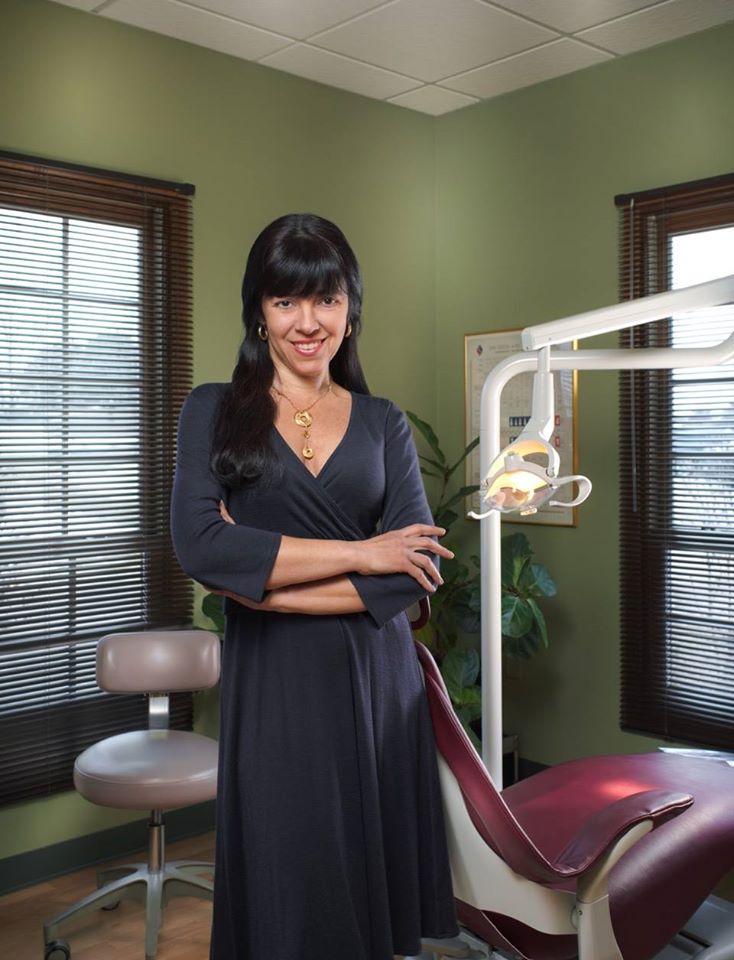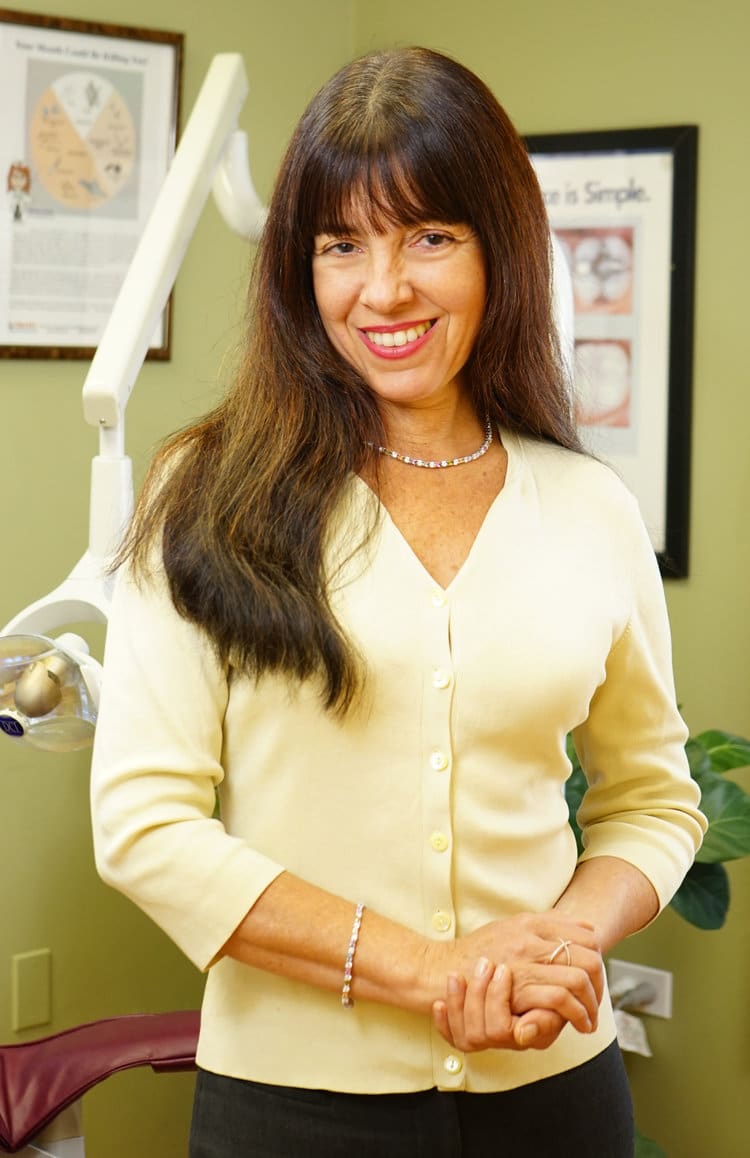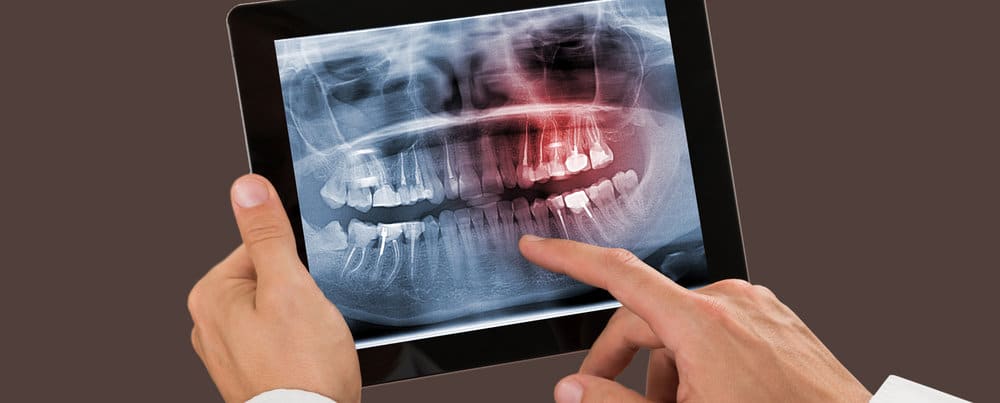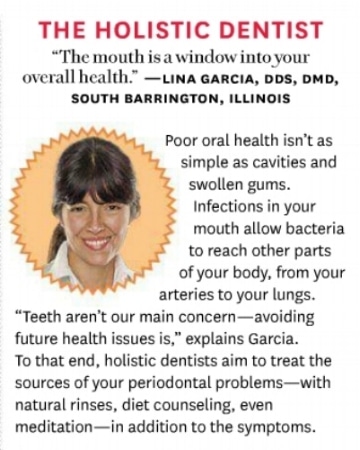Checkout Dr. Lina Garcia, DDS, DMD Watch Video
Dr. Lina Garcia is a Doctor of Medical Dentistry as well as a Doctor of Dental Surgery.For over 30 years, Dr. Garcia has been dedicated to the research and teaching of alternative solutions for conventional dentistry.Dr. Garcia is also trained in cranial osteopathy and works with an osteopathic physician and a nutritionist to help guide her patients toward optimal dental and overall health.
Dr. Lina Garcia has been on staff at Alexius Medical Center in Hoffman Estates, Oral Surgery Group in Merrillville, Indiana and Methodist Hospital in Gary Indiana. She graduated from the University of Nova Friburgo Dental School in 1985 and did her residency at Sesi Hospital in Rio de Janeiro. She graduated from the Boston University Advanced Dental Program in 1991.
Dr. Garcia has trained around the world and is excited to be able to offer holistic services at her practice. She sees patients from all over the United States and worldwide, and looks forward to seeing you in her office. Dr. Garcia works very hard to accommodate out-of-state patients. If you are unable to travel, phone consultations are available by appointment.
Why Be Concerned About Root Canals?
Fundamental to the understanding supporting holistic dentistry is that dental procedures and materials can have an effect on your whole body and not just your teeth. A root-canal procedure can lead to a number of chronic health problems and even degenerative diseases.
Why Be Concerned About Fluoride In Dental Treatments and Drinking Water?
The risk of fluoride to health is something that everyone needs to understand. Even though fluoride may reduce tooth decay in some people applied topically, it is toxic to the rest of the body, so it is likely to create health problems, especially when ingested (as in fluoridated drinking water, fluoride-containing toothpaste, and fluoride-containing oral rinses).
Root Canals – What are the trade-offs?
In order to make a wise choice in our health care, it is necessary to understand the trade-offs assumed when dead tooth structures are left in the mouth for extended periods of time (decades in many cases). If you are surprised by the idea that a root canal leaves dead tissues in the body, please read the next question (What,exactly, is done in a root canal procedure?).It may seem like a good idea to keep the dead root remnants of the natural tooth in place, however, research as shown that there are significant consequences that should be considered.Remember that the fundamental understanding that supports holistic dentistry is dental procedures and materials can have an effect on your whole body, not just your teeth. In the case of a root-canal procedure, it can lead to a number of chronic health problems and even degenerative diseases.Current practice in conventional dentistry assumes that a root-canal treated tooth is “cured,” thereby discounting the possibility of infection and resulting disease development. However, this attitude is beginning to change as our understanding of the complexity of the body and the origins of auto-immune diseases lead
more and more people (researchers, health care professionals, patients) to re-examine the pros and cons of the root-canal procedure.In addition to potentially being a causative factor for a specific degenerative disease*, a root-canal-treated tooth can also be a direct cause of a wide variety of ailments, such as infections, inflammation, pain, blood cell abnormalities and fatigue. Although I acknowledge there are special circumstances in which a root canal has short-term value, I believe
that phasing out the procedure as a standard-of-care practice would significantly reduce the amount of chronic illnesses that burden the American people.
*For example:
October 2017
• Arthritis
• Meningitis
• Pneumonia
• Appendicitis
• Anemia
• Heart lesions
• Endocarditis, myocarditis (heart inflammation)
• Hardening of the arteries
• Nervous system breakdowns
• Eye infections
• Kidney, liver and gallbladder problems
• Cancer
What, exactly, is done in a root-canal procedure?
A root-canal procedure involves the removal of the soft pulp tissue inside a tooth. The soft pulp is located in the root canals that run through the middle of the harder tissue inside a tooth, called the dentin. The canals start in a part of the tooth called the pulp chamber and extend to the end of each root. (Front teeth generally have only one root, while molars usually have two or even three roots.) The roots of teeth are anchored into the jawbone by way of the periodontal ligament, which develops from both the bone and the teeth. The pulp extends from the pulp chamber down through each root canal to the bottom of the root in the jawbone. The pulp contains blood vessels, lymphatic fluid, nerves and connective tissue that are essential to keep the tooth alive and healthy. A root-canal procedure is typically done when the soft pulp tissue inside a tooth becomes infected and/or inflamed, or because a tooth is abscessed. The infection or inflammation can have a variety of causes, such as deep decay, repeated dental procedures on a tooth, a chip or crack in a tooth, or a fracture in a tooth resulting in exposure of the pulp and nerves. An abscessed tooth occurs when pus forms at the root of an infected tooth. Any of this can occur with or without the presence of pain or other symptoms. The objective of a root-canal procedure is to remove all of the soft pulp inside a tooth, which obviously also eliminates the blood supply, lymphatic circulation and nerves in the tooth. Then the hollowed-out pulp chamber is “sterilized,” filled and sealed, always with material that contains some metal (so the root-canal treated tooth can be identified on an X-ray), and finally, a crown is placed over the pulp-less tooth. (For some teeth, however, the root-canal procedure is completed by using a filling instead of a crown.) The root-canal procedure is often described as “saving” the tooth, rather than extracting it. But to phrase it as “saving” the tooth is not quite accurate because if the tooth is not already dead (for example if it is still producing painful sensations), having a root-canal procedure means that the dentist is actually removing living tissue, which results in “killing” the tooth. In cases of intense pain, it may be thought of as a “mercy killing,” as having a root canal can definitely be an effective way to eliminate the pain — kill the tooth and you kill the pain. The pain is gone because the nerves are gone. However, a much more accurate, no nonsense way of describing the end result of a root canal is this: It doesn’t “save” the life of the tooth, but it does keep enough of the tooth’s hard outer structure intact so that the crowned chewing surface will be functional, while maintaining the aesthetic value of the tooth. So there you are — you are now left with a functional but dead tooth in your mouth that looks good when you smile. But think about this for a moment. Doesn’t it seem unhealthy, and even strange, to leave a dead tooth in your mouth? If another organ in your body were dead, it would have to be removed or else very aggressive strains of microbes that nature uses to decompose dead tissue would set in and threaten your life! And something similar happens with a dead tooth, whether it is killed from infection, trauma or the root-canal procedure. After a root canal is done, the dead tooth is an environment conducive to chronic infection (growth of anaerobic bacteria and the toxins produced by the bacteria). Because there is no reliable way, practically speaking, to completely sterilize a root-canal-treated tooth, (while it is still in a patient’s mouth), it may be a source of infection for the whole body until it is extracted and the tooth socket is cleaned. Because chronic infection can occur without the presence of pain or other symptoms in or near the root canal treated tooth, it is often overlooked when diagnosing the cause of illness.
What Exactly Is Fluoride?
“Fluoride” is a generic term used to describe a chemical compound containing the element fluorine, as well as one or more additional elements. In its pure state, fluorine is a yellowish gas that is extremely corrosive and poisonous. It is known to be the most reactive of all the elements in the Periodic Table of Elements. Because of this, fluorine exists in nature only in combination with at least one other element. So, fluorine + calcium = calcium fluoride; fluorine + sodium + aluminum = sodium aluminum fluoride. Important Note: Fluoride-containing chemical compounds are also the primary hazardous-waste products that have been, and continue to be, generated by a number of enterprises, such as the phosphate fertilizer and aluminum industries. Because of the prevalence of fluoride in the Earth’s crust, these industries and others that mine for raw materials inevitably produce varying amounts of fluoride containing hazardous waste as a byproduct of their ore extraction and refinement processes.
Is Fluoride A Nutrient Or A Necessary Mineral?
No. Fluoride is not a nutrient for our teeth. We don’t need fluoride to prevent tooth decay, nor do we develop tooth decay because we are deficient in fluoride. It is well established that fluoride has no nutritional value for the human body.
Is Fluoride A Drug?
The FDA confirms that fluoride meets the legal definition of a ‘drug’ and has approved its topical use in toothpaste and mouthwash but has not reviewed nor approved fluoride when it is to be ingested for a reduction in tooth decay. Proponents have yet to produce any controlled, peer-reviewed studies showing that long-term ingestion of fluoride compounds is safe.” (See ww.safewateroregon. org/fluoridation.html for more information).
Is Fluoride Dangerous To Health?
The danger that fluoride can present is most obviously supported by the warning printed on every box and tube of fluoridated toothpaste: “If more than used for brushing is accidentally swallowed, get medical help or contact a Poison Control Center right away”.






